Author's Note: Here are links to previous episodes of this series:
Preamble
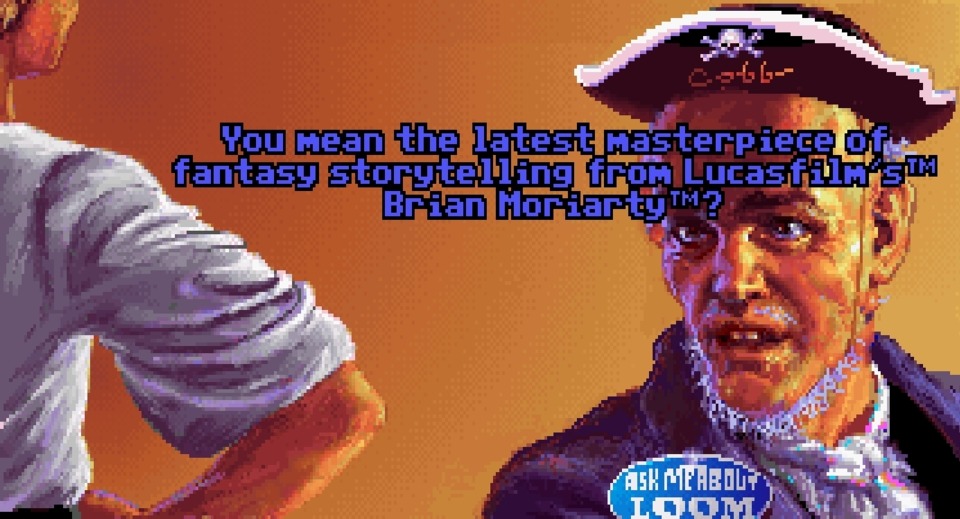
Oh, Loom, what am I to make of you? You are a game most people only know, thanks to Monkey Island. However, you represent a significant break from what LucasArts pioneered during its "Golden Age," and for that reason, I respect you. Unlike other LucasArts titles from this era, Loom is one of the few from the legendary studio that circumnavigates the SCUMM engine. Rather, it uses a complex music-based inventory mechanic. As a result, you don't pick up items and put them into slots as you do in any other classic adventure game. Instead, you observe your surroundings and see if they have any hidden knowledge or music to share. It's a novel system and one that I want to laud for doing something different. Nonetheless, I can't afford the game even that, for reasons I will articulate at the end of this blog.
Likewise, I feel like Loom is a perfect reason why I started this series in the first place. Many of you will recall that during my series on The Dig, I mentioned how it and The Dig were the only LucasArts games that ever gave me trouble during my childhood. Part of my struggle was due to Loom's then genre-breaking gameplay. Many years ago, I refused to accept the game for what it was and was obstinate about not playing it by its own rules. Now, as an adult, I had an easier time with Loom and managed to complete it in about four to five hours. This point leads us to Loom's best and worst aspect: its manageable playtime. I would struggle to thoroughly recommend the game to anyone not already a fan of classic point-and-click adventure games. Nevertheless, it's worth a passing gander thanks to its breezy pace and short playtime for long-time adventure game fans.
HUD & Controls
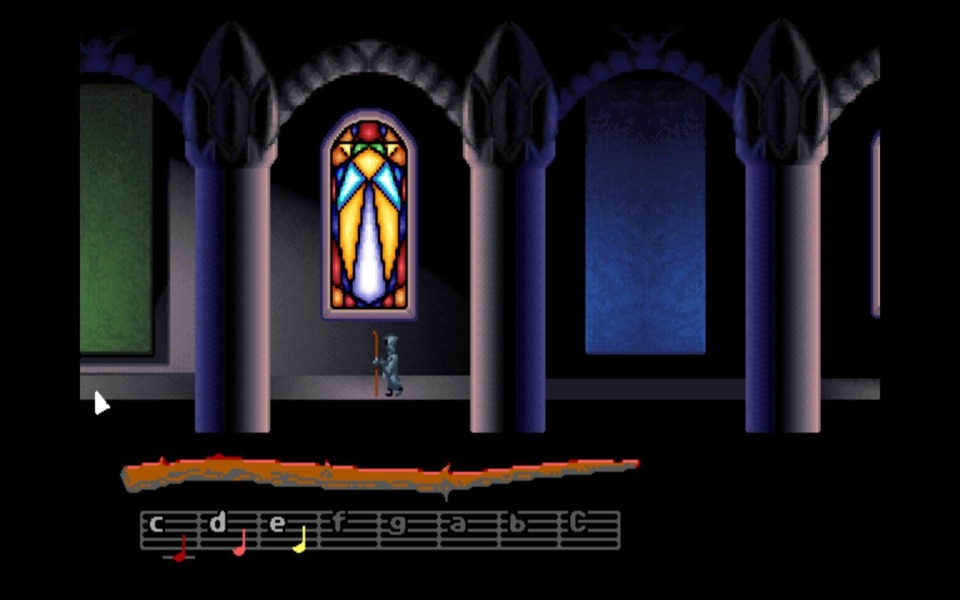
I'm going to break with tradition on this series and spend some time reviewing how Loom controls. Previously, I felt like saying "Yo, this game uses the SCUMM Engine" or "This is a Myst clone" sufficed with the past two games. However, no game controls or plays like Loom, which is why it continues to divide adventure game fans to this day. The first thing to note is something that continues to screw over everyone who buys the digital-only releases of the game: you need to write down your spells. There are a handful of occasions where NPCs sing or dance their magic exactly once, and if you fail to jot down their musical notes, you will enter a fail state and be unable to continue. The game's original release came with a manual and a handy reference guide to boot. However, with the Steam release, that's not the case. I have heard the GOG version includes this reference sheet as a PDF, so if you are interested in playing this game, I would recommend that version first.
The second big shock is that the game doesn't allow you to pick up items. Instead, you will interact with everything and everyone around you using Bobbin's (i.e., the protagonist) magical staff. You are not combining rubber chickens with pulleys in Loom. There is no cat hair mustache to assemble. The HUD of Loom is sparse, with your "Distaff" being the only thing to occupy the bottom portion of your screen. There are no grids of usable verbs. Nor is there a 3x3 matrix of inventory items. Rather, you need to trigger different parts of your present environment to play music and heed the notes of those songs. It's something that takes some getting used to, but eventually, you'll come to enjoy it for the most part. One of the more fiddly aspects is that every spell, outside of one, requires you to select an object or person before it allows you to cast magic. You can't just start playing music out in the open and hope the spell lands on its destined target. Sometimes the target of your spells is not clear, or there are more logical recipients for them than what the game will allow, and that is never not frustrating.
Loom Puzzle Ratings (In Chronological Order)
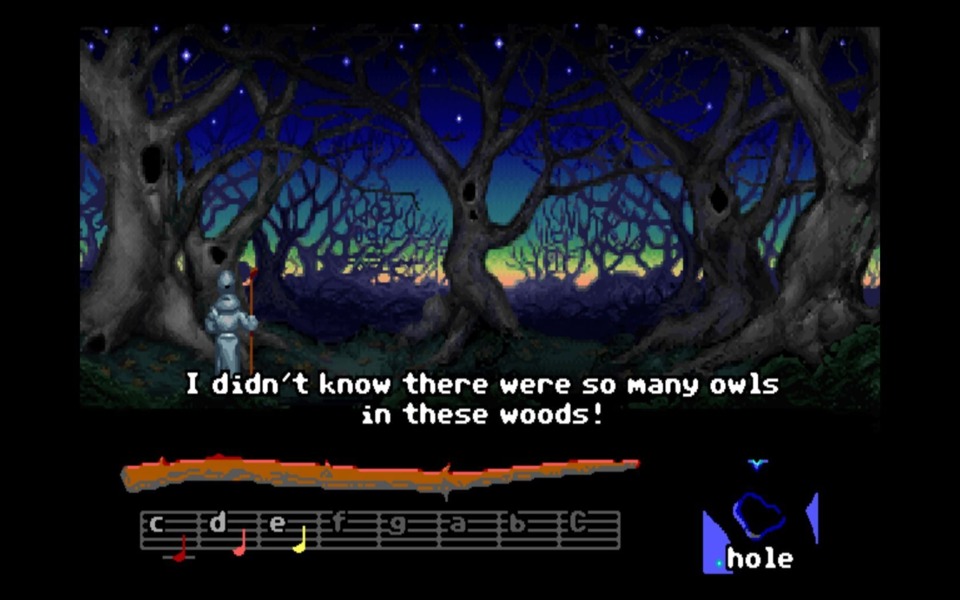
The Village Part I (aka Getting Hetchel Out Of The Egg) - 1/10 - This puzzle is an almost flawless tutorial on how Loom operates. It nearly perfectly communicates how differently it controls over other SCUMM-based LucasArts adventure games. The only hindrance is that it can be easy to miss the last leaf of autumn during the introduction, and also, Loom in-game does not adequately warn you about needing to take notes for all of your spells. Otherwise, I enjoyed learning your first batch of spells from the loom as it clued you into needing to pay attention to your current environment to discover additional magic. A nearby egg teaches you the "Open" spell, and learning it, alongside the "Transcendence" spell, are perfect first-step puzzles.
The Graveyard - (aka Getting the Night Vision Spell) - 1/10 - Here's another easy tutorial on the magic and simplified inventory systems. You get a rabbit out of a pile of thorns, and it gets eaten by an owl, which allows you to get the "Night Vision" spell. At this point, I wished the game announced the names of the songs or had a spell list in-game. However, the game's audio cues are excellent. Like the previous level/environment, you can immediately test out your newly acquired spell. This design decision addresses a common issue with adventure games wherein you pick up an item and then wait until later to use it. However, as is often the case with the latter format, you forget you even have the necessary objects to solve a puzzle when the time comes to use them.
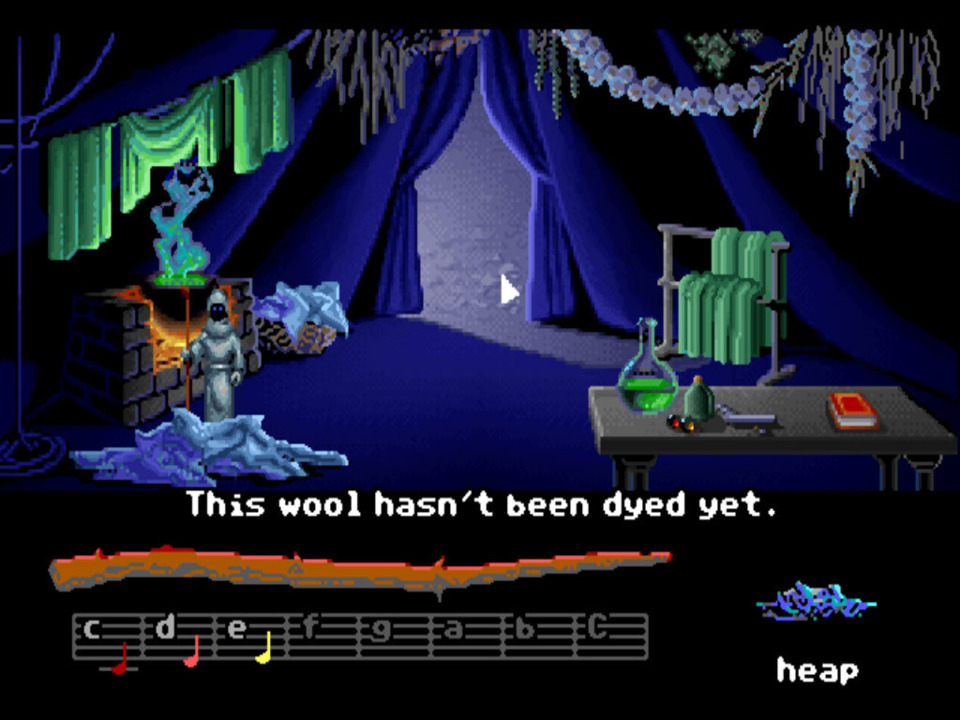
The Village Part II - (Spell Pickup And Checking Out The Other Tents) - 2/10 - Here, Bobbin needs to return to the village and enter the tent in the middle. Upon doing so, they need to select the darkened portions of the tent, which are selectable as "Darkness," and then perform the "Night Vision" command. With the inside of the tent illuminated, you'll find a bale of hay and a spinning wheel. The wheel teaches you the "straw-to-gold" spell, and you can use it on the hay bale next to you. You also learn that performing songs reversed can have the opposite effect, and doing so on the newly created pile of gold turns it back into straw.
You then explore Hetchel's tent, which has two spells for Bobbin to learn. A flask teaches "Empty," and the cauldron has "Dye." Like before, there are items in the environment for you to practice your news spells on, but doing so is not a requirement. I give this a two instead of a one because of the unintended consequences of the reversal mechanic. The game is not clear enough about you playing magic reversed. Otherwise, after picking up the night vision spell, you revisit the other tents and see which ones have spells you can pick up. I also have to question if the game signposts you enough to get these spells. There's no doubt in my mind that the game's open-ended format can result in some players missing crucial resources necessary later in the game.
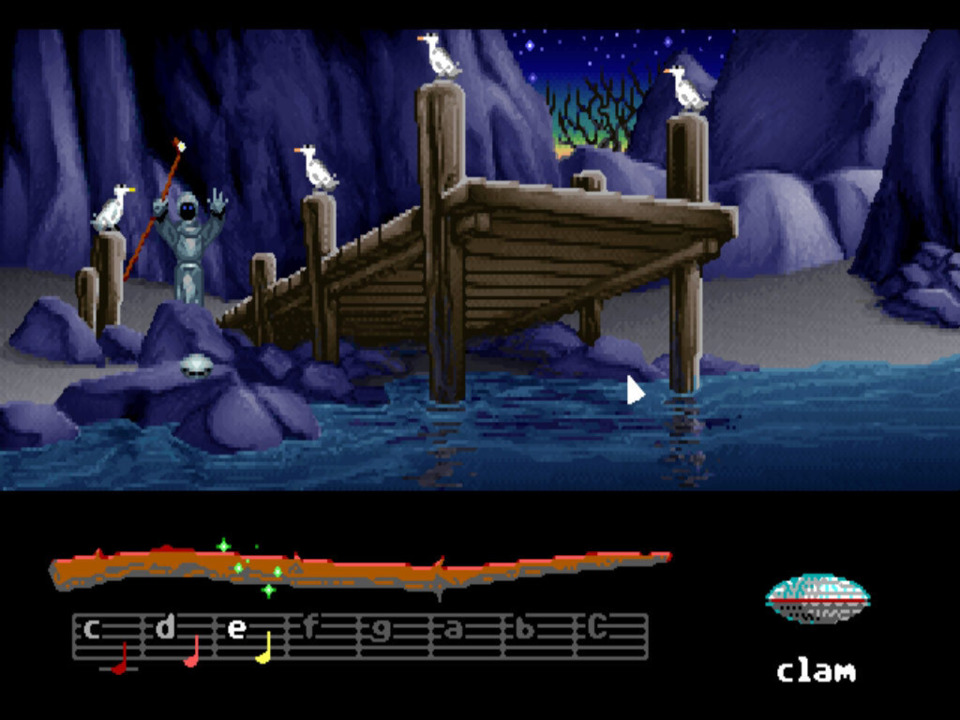
Exploring The Docks & Getting the F Letter on the Distaff - 3/10 - It's time to explore the last part of the village you have yet to visit: the docks. While at the docks, there is a clam you need to use the "Open" command on to pick up a story item. This set piece is slightly above a one only because the clam can be hard to see, and the spell that the gulls provide is a bit of a red herring.
Returning To The Hill - (Use Open on The Sky To Summon Driftwood) - 6/10 - Ah, yes, now Loom starts to show its true colors. After you visit the dock, you need to return to the hill at the start of the game and click the sky, and then use the "Open" spell on the stars. The issue here is that this is a massive leap of logic, and the game does virtually nothing in-game to put you down this path. After opening the clam, you return to the village, and nothing is pointing you towards your next step. Thus, this part of the game feels aimless and a bit directionless. It does not help that finding the spot on the screen to click in the sky is tough to find. Also, using the "Open" spell summons lightning that strikes a tree to move a piece of driftwood to the docks. This climax feels a bit too Rube Goldberg for me.
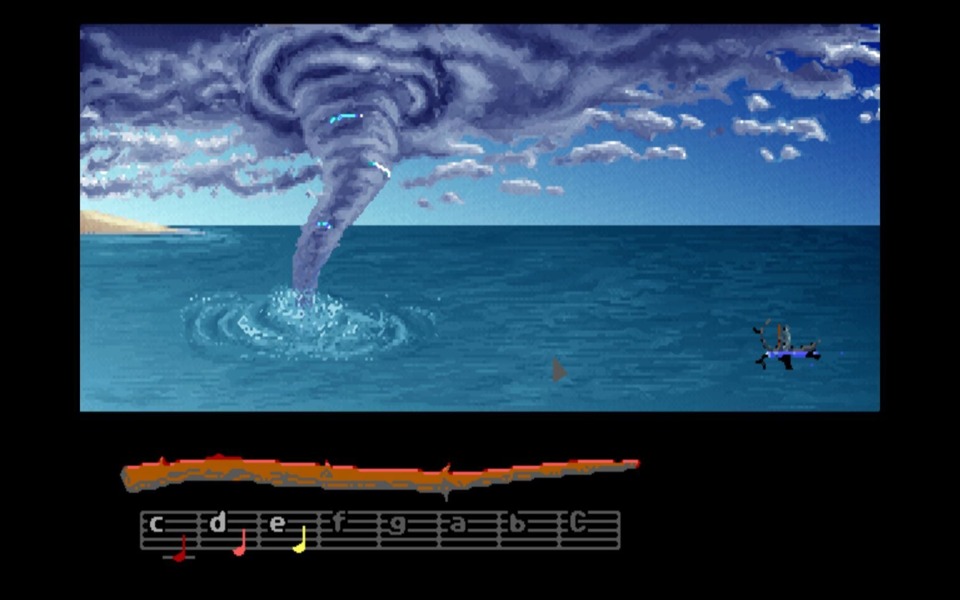
Dock And Ocean Journey - 1/10 - After relocating the branch by the docks, Bobbin boards it to begin a journey across the ocean. The only thing blocking their path is a massive maelstrom. The player has to select the tornado and then use the "Twist" command, but reversed, to cause the storm to disappear. I think this is a clever puzzle, but there's an element of throwing everything at the twister and seeing what sticks.
Entering The Castle - (Getting the Terror Spell to Scare the Shepards) - 6/10 - After the branch lands on a beach, you can see a forest ahead as well as an emerald city. If you attempt to enter the forest, Bobbin is harassed by a troupe of shepherds. As they do so, you can take note of a spell that allows them to become invisible. The command plays out quickly, and I needed to trigger the cutscene more than once before I had it written down. After pocketing it, you can fully explore the emerald city. First, you need to enter a shop, observe a green pillar, and talk to a merchant named "Goodmold." When you exit Crystalgard you can watch a team of workers using a scythe. You need to click the workers and play the "Appear" spell reversed. This allows Bobbin to become invisible and enter the inner court of the green palace. Eventually, you encounter a scrying orb that teaches you the "Terror" spell, and before you leave the city, you need to learn the "Sharpen" spell from the scythe. You can then scare the asshole shepherds and enter a nearby pasture.
I find this entire sequence meddlesome for a handful of reasons. First, you have a narrow window to write down the appearance/disappearance spell when you see the shepherds. Second, the workers you need to cast a spell on are a bit of a pain in the ass to select. The workers are only a handful of blurry pixels from the city's exterior. It would have been much easier if the game allowed you to select Bobbin and cast a spell on himself. However, for whatever reason, you can't do that. The scythe teaching the "Sharpen" spell highlights a different issue I have with Loom. It is sometimes impossible to tell which items in the environment have spells and which ones do not, and the game's logic of what or who can teach magic is scattershot.
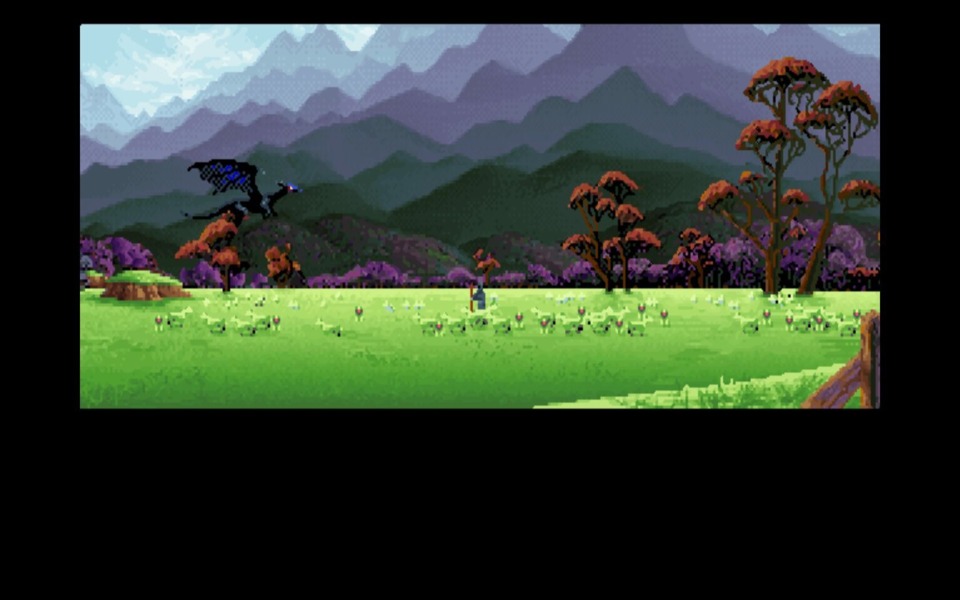
The Pasture - (Dye The Sheep Green And Get Caught By Dragon) - 6/10 - When you first enter the pasture, you find a slumbering shepherd. When you locate a trio of sheep and make them leap over a fence, you learn the "Awaken" command, which, when played in reverse, becomes the "Sleep" command. When you use the Awaken spell on the sleeping shepherd, he chastises you and informs you of a shepherdess in a nearby hut before returning to their slumber. Upon entering the building, you see an ill lamb and the shepherdess. She performs the "Heal" spell and shares how the poor lamb will not get better. She speaks of a dragon snatching sheep from her flock and asks Bobbin for help. When you run to the herd, you dye their wool green, and when the dragon appears, it snatches Bobbin instead of the sheep.
This puzzle is not necessarily challenging; it's just illogical enough that it is a chore to solve without a guide. First, you need to pick up the Awaken/Sleep spell and remember to write it down. It sure would be a bummer to get to the dragon and not know how to cast the Sleep spell. Second, you need to encounter the female shepherd and learn the Heal command. You have precisely one chance to write the song down before you are forced into an environment completely removed from the pasture. As noted in the preamble, I KNOW this isn't as big an issue in the original release because it came with a manual with the spells listed there. However, there's no reference guide in the digital releases, and if you are not quick on the draw, you can completely fuck yourself over and not know it. Finally, dying the sheep green is both clever and infuriating because it has been AGES since you last used the Dye command.
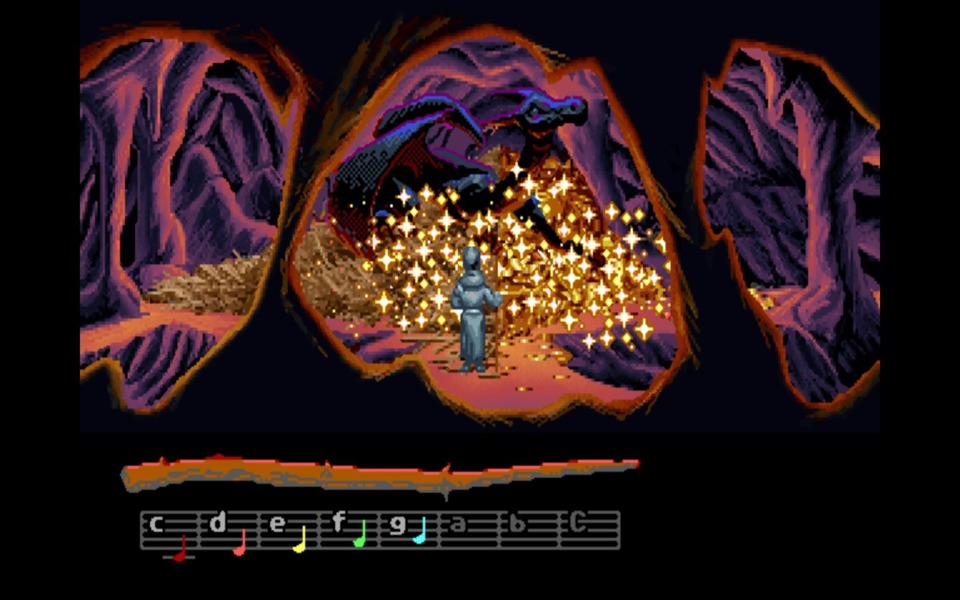
Dealing With Dragon - 3/10 - The dragon is not at all happy to have Bobbin instead of a delicious lamb. The first thing you need to do is perform the gold-to-straw spell on the dragon's pile of gold. As it screams at you to return their gold, you need to put it to sleep, and as it sleeps, it accidentally sets the pile of straw on fire. This allows Bobbin to leave the dragon's lair unscathed. Defeating the dragon is not all that hard. The only tricky part is if you forgot to write down the sleep Spell the one time you learned it. If that is the case, you are officially in a fail state.
Cave Maze - 3/10 - After exiting the dragon's lair, Bobbin finds himself in a pitch-black cave. When you perform the "Night Vision" command, a torch surrounds Bobbin but does not fill the screen. Bobbin then navigates the cave by exploring every nook and cranny. For the most part, the maze is linear, but I cannot for the life of me understand why the Night Vision spell is more narrow and limited in this environment when in others, it is all-encompassing. Luckily, there are only a few dead-ends, and it's only a matter of "when" you will finish this maze rather than "if."

Getting Out of the Caves - 4/10 - To get out of the inner workings of the dragon's cave, Bobbin must complete a handful of tasks. First, they need to empty a pool of water to find a scrying orb. The orb showcases a trio of cutscenes and unlocks a pathway to a stone spire. You can flatten the spire to make a path for Bobbin by using the "Twist" spell but reversed. The tricky part about this sequence is knowing how to click the right spots on the screen to perform the actions you want. For example, when starring at the mountain, only a tiny portion of its peak is selectable, and you need to fan through its pixels to find it. The only thing I think is a bit too obtuse is the puzzle with the staircase. My original assumption was that we would need to jump or fly across the gap rather than untwist spire to form stairs. Also, I feel this was when I started to feel like the game's story was a complete afterthought.
Entering the Forge - 5/10 - On the next screen, you encounter a sleeping boy next to a bramble of thorns. When you awake the young man, he introduces himself and mentions a blacksmith's guild at a nearby forge before falling asleep again. When you first approach the forge, its guards rebuff Bobbin's request for entry. To rectify this problem, you need to use the Reflect spell on the boy so that Bobbin will look like them to the guards. When Bobbin meets with the leader of the blacksmiths, they take Bobbin's staff and then throws Bobbin into prison.
In terms of difficulty, this is more fiddly than hard. First, we need to note that if you forgot to write down the tune for the Reflect spell before you evaporate the pool of water, you dun fucked up. Second, knowing that you need to use the Reflect command instead of the Disappearance spell seems odd. I mean, it is a spell that makes you invisible after all. Other than that, it's another weird sequence that is only tricky if you have not been taking notes. I almost wish the bit where Bobbin has no magic went on for longer or was more fully realized. There's a genuine sense of dread of needing to explore an environment without magic that the game only continues for a hot minute.

Dulling The Sword at The Forge - 5.5/10 - Bobbin gets their staff back almost immediately after sleeping for a bit. Next, they need to sneak into a room with a blacksmith and a bishop. While a blacksmith is hammering away in the center of the room, Bobbin needs to sabotage their efforts. They can cast "Twist" to ruin the sword or cast "Dull" to wreck their hammer. This puzzle is oddly time-sensitive, which makes this a bit trickier than some of the earlier times when you need to cast spells. You have to wait until the blacksmith raises the sword into the air. Trying to use the spells while they are hammering yields no results. Nonetheless, I like how this puzzle features two valid inputs (i.e., twist and dull) that lead to two alternate cutscenes depending on which one you use.
Getting Out Of The Evil Guy's Castle - 1/10 - While in most adventure games, the difficulty ramps up, the opposite is true in Loom. Almost all of the late-game puzzles in Loom are cinematic set-pieces rather than full-fledged puzzles to test your mettle. In this case, when Bobbin is locked away in the castle, your only impediment, a guard named "Cob," is defeated without any input from the player. Another orb provides hints about upcoming puzzles, and Bobbin regains their staff without needing to do anything other than watch cutscenes. The only real puzzling you need to do is release a green dragon using the "Open" spell. Other than that, there's nothing to do other than move from one screen to the next.

Closing the Rifts - 3/10 - Bobbin falls into a rift that pulls him into a black void of nothingness. As you move from the rightmost to the leftmost part of the screen, you will find portals to former locations from the game. You return to the pasture at the first rift to heal a handful of dead shepherds and listen to Fleece's story. With the second portal, you encounter Goodmold and hear their dying words before they expire. With the third, you relocate Rusty and bring them back to life. There's one more tear that leads to the cathedral, and with each rift, you need to close them with the "Close" spell. I wouldn't say I like this part of the game because the pond where you meet Bobbin's mother is at the far end of the void. It just isn't fun and, instead, slow and pedantic. Also annoying is how you need to use the "Heal" spell to solve most of the rifts. Again, if you forgot to write it down during the ONE TIME when you heard it, you are fucked. Finally, closing each temporal rift using the "Close" spell is fiddly and annoying.
Beating Chaos - 4/10 - It's time for the big climactic battle against Chaos! First, you need to perform the Silence spell backward. After Chaos murders Hetchel, you need to do this a second time. Luckily, the nearby loom will repeat all of the spells you need to cast to defeat the evil specter. The only tricky part is that some songs need to be performed reversed. Finally, to set back Chaos' efforts for world domination, you need to destroy the loom using a "Rift" spell you only recently learned.
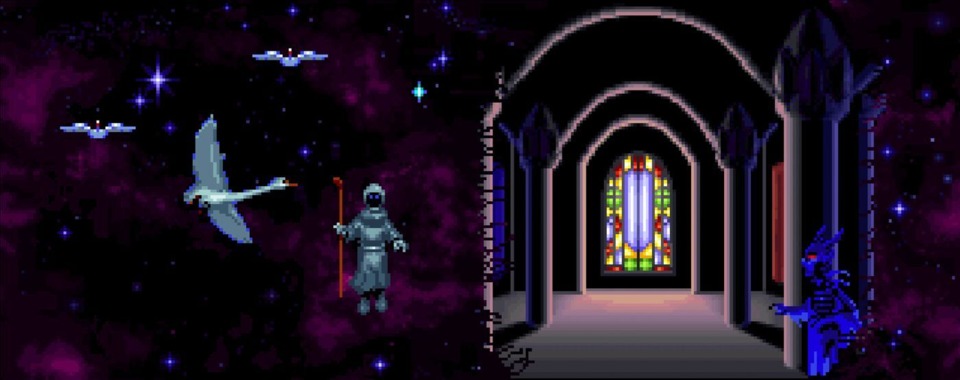
Transcendence Spell - 7/10 - Chaos stands before you one final time, and Bobbin needs to cast the "Transcendence" spell. This song is the second spell you learn in the game, and this scene is the ONLY TIME you use it. Maybe this spell was more straightforward in the original release, but I had to look up the final spell as I played the Steam version. What would have done this game a huge favor is if Transcendence was a communicated recurring leitmotif. Unfortunately, that's not the case. Additionally, the Transcendence spell is THE ONLY ONE you cast on Bobbin! Every other command requires the player to select a secondary target before you can perform even a single musical note. That not being the case here threw me for a loop.
Should You Play Loom? (Verdict: Maybe, But Only Because This Game Is Four Hours Long And Such A Weird Anachronism)
Goodness gracious, what am I to make of a game like Loom? I have to commend the team behind it for going above and beyond the norm to provide an adventure game experience unlike any other. As stated before, no game tries to accomplish what Loom attempts in a single package. It is incredibly compelling how it entirely sidesteps and inverts fans' expectations of how a LucasArts adventure game plays and feels. Its puzzles are far more abstract and conceptual than what you find in Monkey Island, Day of the Tentacle, or Sam & Max. As a result, this game is a breath of fresh air for those who have exhausted the adventure game genre and its tired and true conventions.
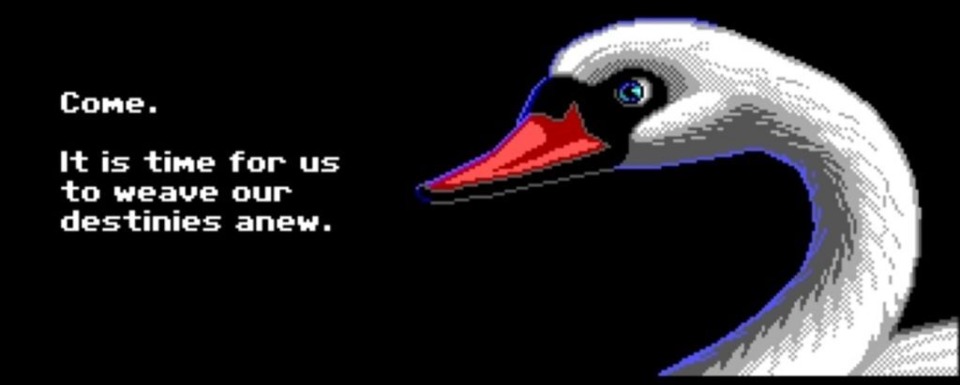
All that aside, Loom is half a game. At four hours, Loom stops right as you start to wrap your brain around its mechanics and logic. The puzzles, while novel, are sparse, and the lack of contextual clues can result in many players getting stuck. The story is nonexistent and borders on being incoherent at times. And before you ask, I did listen to the audio drama players are meant to listen to before starting the game. Even then, it's wild to me how both the audio drama AND the game have entirely disparate themes, ensemble casts, and narrative structures. Newly introduced characters die within minutes of their establishing scenes. A handful of character-based plot threads and other story arcs remain half-baked. While some fans cite this as evidence that Loom was meant to be a trilogy, the game's director, Brian Moriarty, suggests otherwise. All signs point to a development team that was trying to bite off more than it could chew and left whole portions of their game underdeveloped. Furthermore, it's not an easy recommendation for people new to the genre. The music-based inventory system threw adventure game fans at the time for a loop, and the same applies to most general video game fans of today.
Finally, if your notion of a "good" or "great" LucasArts game relies on witty dialogue or clever storytelling, neither of those qualities are present in Loom. I would even go so far as to suggest Loom has the least impressive writing in LucasArts' whole adventure game catalog. Bobbin has no personality, and the same applies to virtually every named character you meet. Worse, the game's ending is a complete anti-climax and a divisive point of contention between its own fans. As a result, I would declare Loom a video game aberration. Nothing it attempts signifies anything significant or material for the genre it represents. For many, that is reason enough to afford it a cursory look. With its truncated playtime, you honestly have very little to lose for providing it as much. However, it would help if you went into it with realistic expectations knowing the game is an interesting adventure game evolutionary dead end.
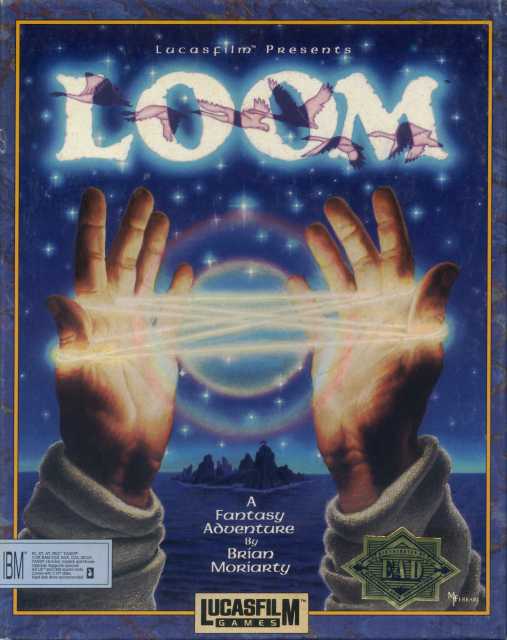
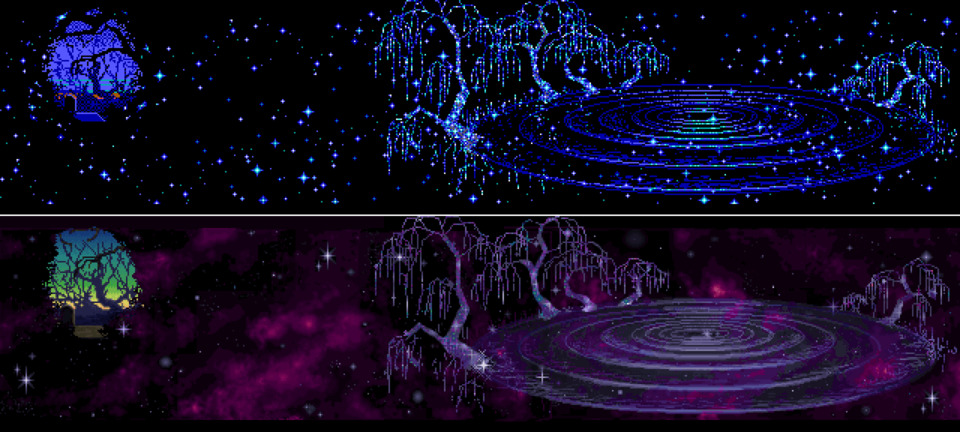
Log in to comment